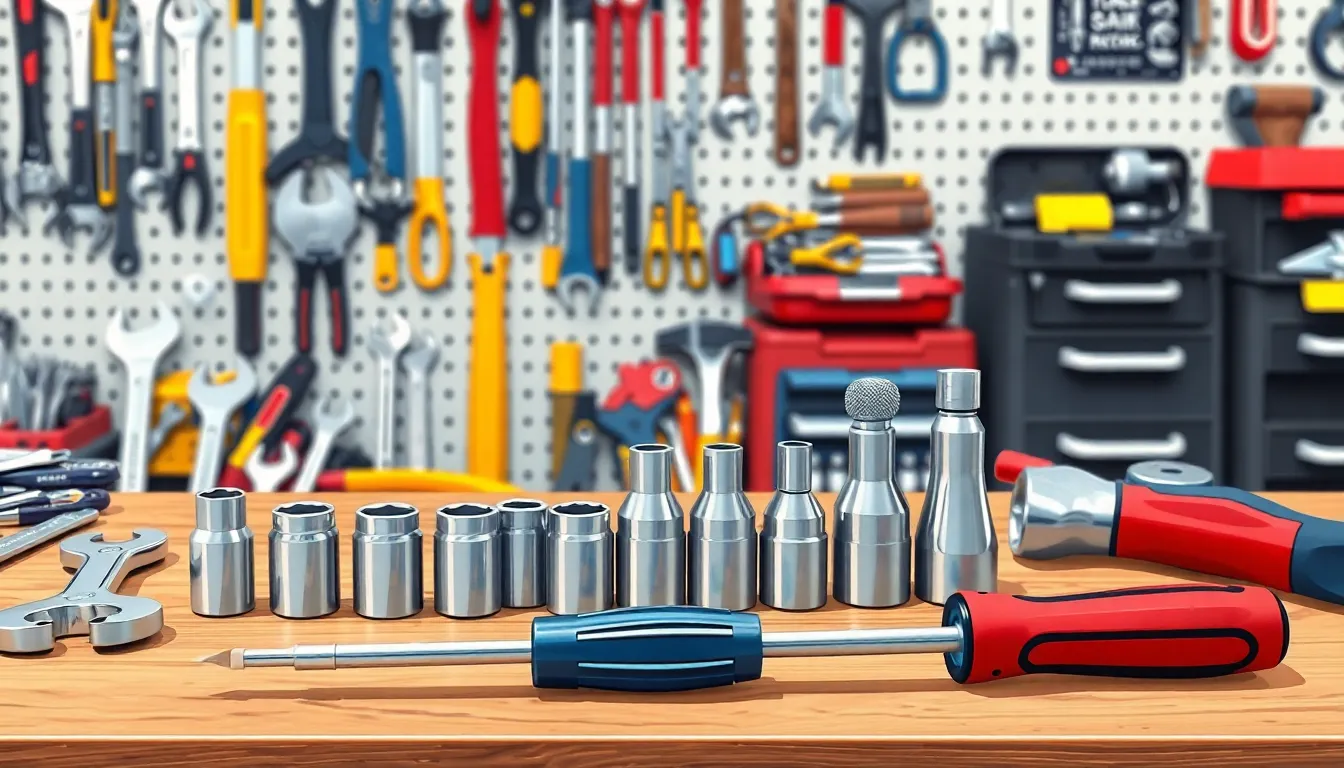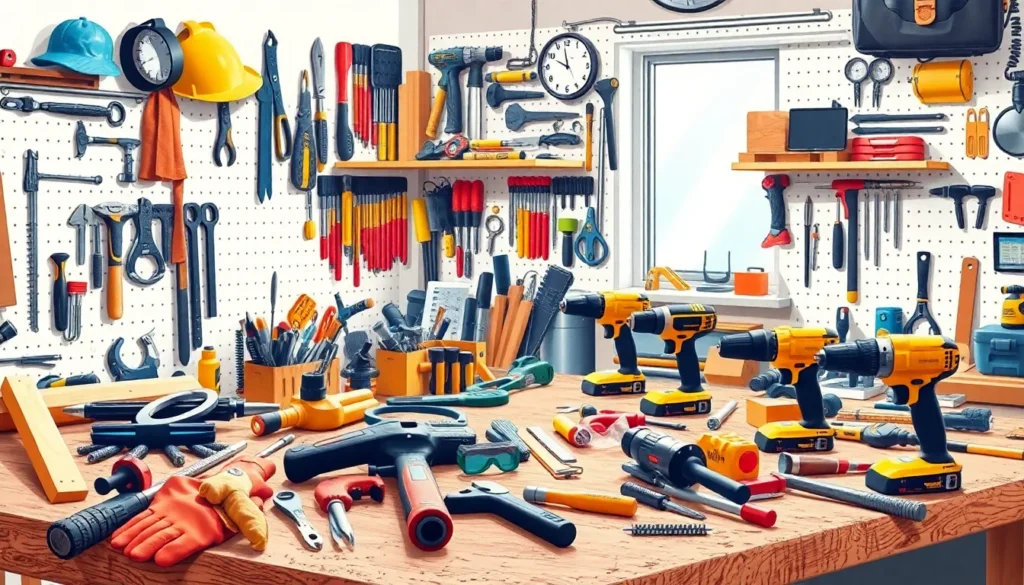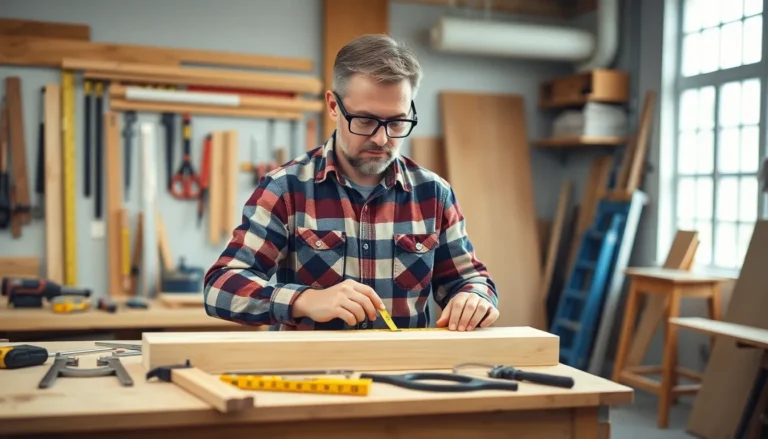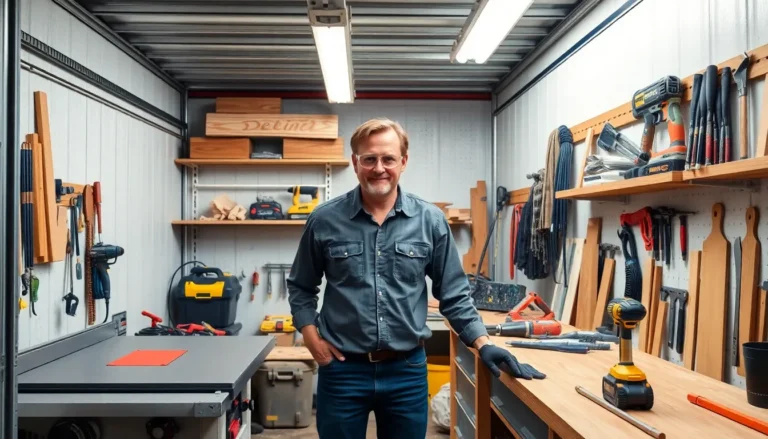Table of Contents
ToggleEvery DIY enthusiast knows that the right tools can make or break a project. Picture this: you’re knee-deep in a home improvement task, and suddenly your trusty hammer decides to take a vacation. Panic sets in, and you realize that without the right workshop tools and equipment, you’re just a person with a dream and a very stubborn piece of wood.
Overview of Workshop Tools and Equipment
Workshop tools and equipment play a crucial role in achieving successful DIY projects. Hand tools such as hammers, screwdrivers, and pliers serve as the foundation for any workshop. Power tools like drills, saws, and sanders enhance efficiency and precision in various tasks. Furthermore, specialized tools, including routers and chisels, support intricate work and finishing touches.
Storage solutions also contribute significantly to an organized workspace. Toolboxes and shelving keep tools easily accessible, reducing time spent searching for equipment. A well-organized workspace promotes safety and productivity, allowing individuals to focus on their projects.
Safety equipment should never be overlooked. Protective eyewear, gloves, and earplugs minimize risks associated with DIY activities. Investing in high-quality safety gear ensures a safe working environment and promotes confidence while using various tools.
Moreover, understanding each tool’s purpose and proper usage is essential. Familiarity with equipment leads to improved craftsmanship and allows for better decision-making in project planning. Beginners should consider starter tool kits that offer a selection of essential tools for various tasks.
Regular maintenance of tools extends their lifespan. Keeping tools clean, lubricated, and properly stored prevents wear and damage. Consistent upkeep not only saves money but also ensures reliable performance during projects.
The right combination of workshop tools and equipment forms the backbone of any successful DIY endeavor. Prioritizing quality, safety, and organization leads to better project outcomes. Familiarity with tools, coupled with consistent maintenance, enhances overall experience in the workshop.
Essential Hand Tools

Hand tools serve as the backbone of any workshop, providing the capabilities needed for various tasks. Understanding the specific functions of essential hand tools enhances efficiency and craftsmanship.
Wrenches and Sockets
Wrenches come in many varieties, including adjustable, box-end, and open-end styles, making them versatile for different bolt sizes. Socket sets often feature a range of sizes and drive types, catering to many tasks. Both tools allow for easy access in tight spaces, making them essential for automotive and mechanical work. A ratchet mechanism in socket wrenches saves time and effort during repetitive tasks. Regular maintenance, such as keeping wrenches clean and dry, ensures longevity and performance.
Screwdrivers and Hammers
Screwdrivers vary in types, including flathead and Phillips, allowing compatibility with different fasteners. Hammers, including claw and sledge types, provide the necessary force for driving and removing nails. Both tools are fundamental for assembly and disassembly in DIY projects. Magnetic tip screwdrivers enhance precision and control, reducing the likelihood of dropped fasteners. Regular inspection keeps the striking faces of hammers intact, ensuring safety and effectiveness during use.
Power Tools
Power tools significantly enhance productivity in any workshop. Specific types such as drills and saws are essential for various projects.
Drills and Saws
Drills come in multiple types, including cordless and corded options, catering to both portability and power. They excel in creating holes in wood, metal, and plastic, making them versatile for DIY tasks. Saws, on the other hand, include circular, jigsaws, and reciprocating saws. Each type serves distinct purposes, from precision cuts to demolishing materials. Using the right saw simplifies tasks like trimming lumber and cutting tiles, ensuring accuracy and efficiency.
Sanders and Grinders
Sanders are designed to smooth surfaces, allowing for a polished finish on woodwork. They come in various forms, including orbital and belt sanders, each suited for specific tasks. Grinders also play a critical role, used for sharpening tools and grinding materials. Angle grinders are particularly versatile, able to cut through metal and stone. Employing these tools boosts the quality of projects, leading to a refined and professional appearance.
Measuring and Layout Tools
Measuring and layout tools are essential for precision in any workshop environment. Accurate measurements lead to better results in DIY projects.
Tape Measures and Levels
Tape measures provide quick and flexible measurements for various project needs. Many feature durable blades and easy-to-read markings, enhancing usability. Levels ensure structures are even and straight, crucial for hanging items like shelves or artwork. Different styles, including torpedo levels and digital levels, cater to specific applications. Using these tools together streamlines the measuring process and enhances the overall accuracy of projects.
Squares and Calipers
Squares assist in achieving right angles and ensuring cuts are straight, making them indispensable for framing or layout work. Various types, such as framing squares and combination squares, serve distinct purposes. Calipers measure internal and external dimensions, offering precise data for intricate tasks. They can be digital or manual, providing versatility based on user preference. Employing squares and calipers significantly improves the quality and craftsmanship of any project.
Safety Equipment
Safety equipment plays a crucial role in preventing injuries during workshops. Proper gear ensures protection from hazards associated with various tools and materials.
Personal Protective Gear
Personal protective gear includes items like goggles, gloves, and helmets. Goggles shield eyes from debris and harmful dust, while gloves protect hands from cuts and chemicals. Hearing protection is vital when using loud power tools to prevent long-term damage. Safety boots with steel toes offer additional protection against heavy materials. Respirators or masks can guard against inhaling harmful particles or fumes. Using the right equipment mitigates risks while engaging in DIY tasks.
Tool Safety Practices
Tool safety practices help maintain a secure workshop environment. Always inspect tools before use, checking for damage or wear. Proper storage methods prevent accidents, keeping tools organized and out of reach when not in use. Following the manufacturer’s instructions ensures safe operation, especially for power tools. Additionally, using tools for their intended purpose prevents misuse that can lead to accidents. Staying focused and avoiding distractions while working further enhances safety. Adopting these practices cultivates a safe and efficient workspace.
Maintenance and Care for Tools
Maintaining tools ensures longevity and reliability. Regular cleaning after use prevents dirt and debris buildup. Lubrication of moving parts, such as hinges and blades, enhances performance. Inspection of tools for damage identifies issues before they worsen.
Storing tools properly contributes to their lifespan. Hang tools on pegboards or place them in designated toolboxes. Organizing tools reduces the risk of damage and makes them easily accessible. It is crucial to keep power tools in dry environments to prevent rust.
Sharpening cutting tools improves efficiency. A dull blade requires more force and increases the risk of accidents. Using sharpening stones or electric sharpeners keeps blades in optimal condition. Following manufacturer guidelines ensures proper techniques and preserves tool integrity.
Calibration of measuring tools is essential for accurate results. Regular checks of tape measures and levels prevent misalignment in projects. Keeping measurement tools in good condition directly impacts the quality of work.
End-of-season maintenance is beneficial for seasonal tools. Winterizing outdoor power tools protects them from harsh conditions. Cleaning and storing them properly boosts their readiness for the next season.
Overall, careful attention to maintenance practices maximizes tool performance and safety. Prioritizing these actions leads to effective and enjoyable DIY experiences.
Equipping a workshop with the right tools and equipment sets the foundation for successful DIY projects. From essential hand tools to advanced power tools each item plays a critical role in enhancing efficiency and craftsmanship. Prioritizing safety through protective gear and understanding proper tool usage minimizes risks and fosters a productive environment.
Regular maintenance and smart storage solutions ensure tools remain in peak condition while promoting an organized workspace. By investing time in learning about tools and their applications DIY enthusiasts can transform their creative visions into reality. With the right approach to tools and safety anyone can enjoy a rewarding and effective DIY experience.




